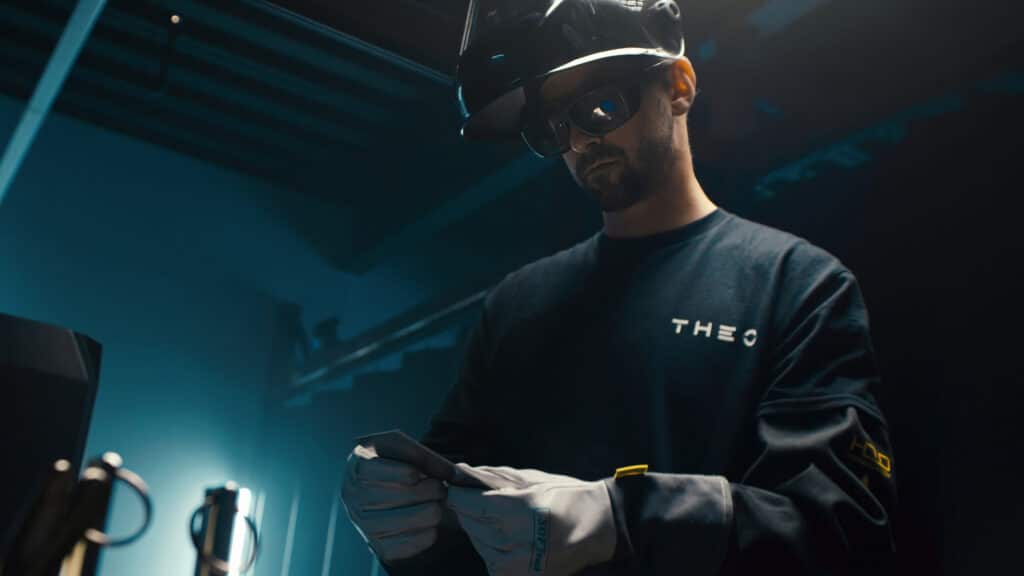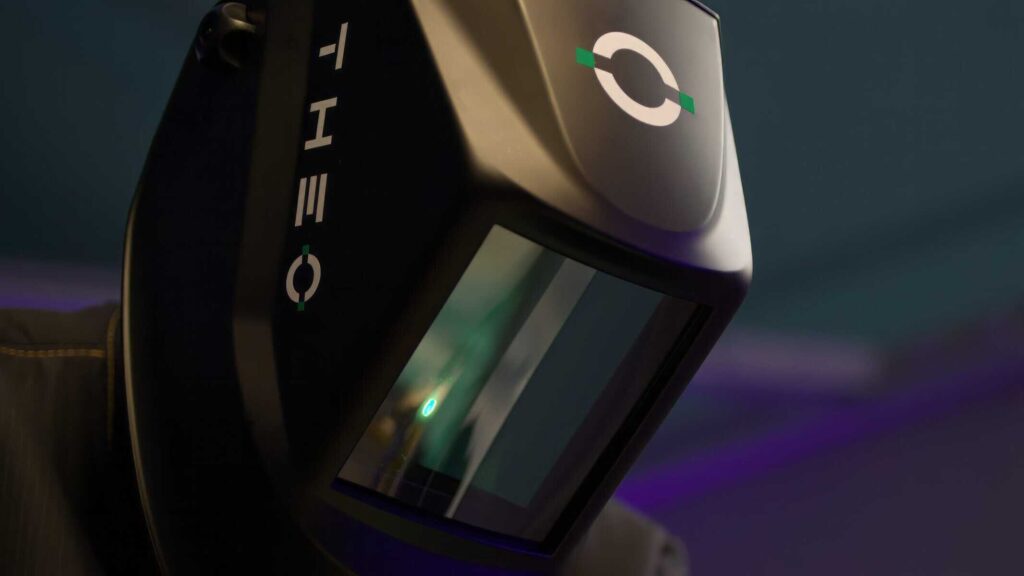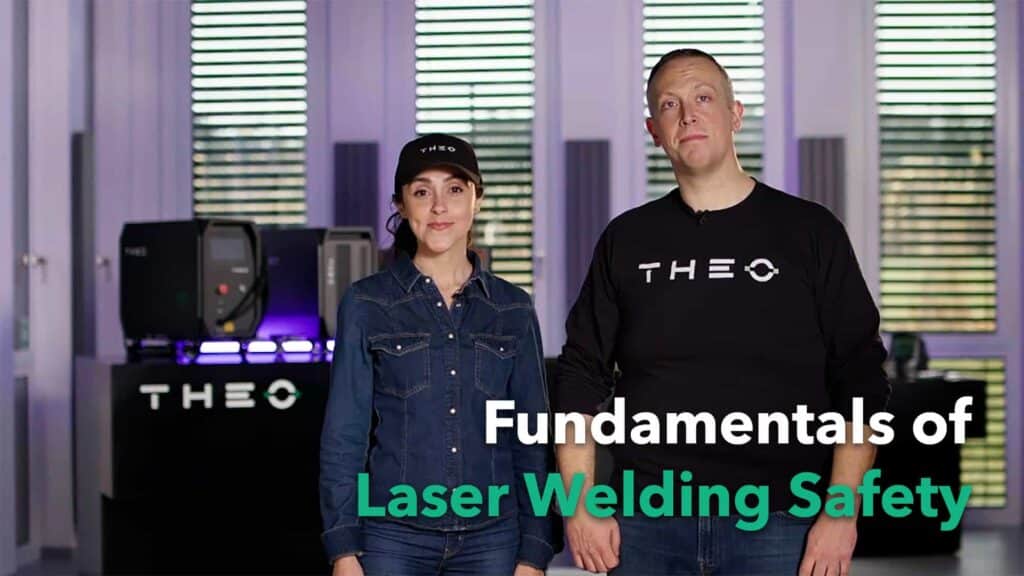Laser welding utilizes high-intensity laser beams to fuse metals – a technological advancement with immense benefits. However, this innovation also presents significant hazards. Invisible laser radiation, UV light, heat exposure, and fumes can pose serious risks to welders.
To ensure a safe working environment, technical safety measures such as emergency stop switches, interlock systems, and fume extraction systems are crucial. In addition, personal protective equipment (PPE) is equally essential. Only a combination of well-designed devices, a secure workspace, and appropriate protective gear can guarantee safe work.
In the European Union, personal protective equipment (PPE) must comply with the EU Regulation 2016/425, ensuring that safety gear meets strict standards for worker protection. Additionally, laser welding safety is governed by EN 207 and EN 208 for laser eyewear, EN ISO 11611 for protective clothing, and EN 149 for respiratory protection. Compliance with these regulations ensures that all equipment provides effective protection in industrial environments.
In this article, we outline the essential PPE components for laser welding with THEO devices, with a focus on European safety standards and compliance.
Why is PPE essential for laser welding?
Laser welding differs from traditional welding methods such as TIG or MIG welding due to its precise and concentrated energy application. But this concentrated energy also presents unique risks:
- Laser radiation – Invisible infrared (IR) and ultraviolet (UV) radiation can cause severe eye and skin damage.
- Heat & sparks – Metal is melted during the process, generating molten spatter and sparks that can burn clothing, unprotected skin, and surrounding surfaces.
- Fumes & vapors – The evaporation of metal and surface coatings produces toxic fumes and fine dust particles, which can irritate the respiratory system or lead to long-term health issues if inhaled.
- Reflections – High-energy laser radiation can reflect off shiny metal surfaces, leading to unintended exposure.
To protect yourself and your work environment, wearing the right personal protective equipment (PPE) is essential.
The most important PPE for laser welding
To minimize the risks associated with laser welding, using the correct protective gear is crucial. Below are five key PPE components that should always be part of a welding setup:

Eye protection: Safety glasses
Risk: Invisible infrared and UV radiation can cause retinal damage within seconds.
Recommended PPE:
- When using THEO devices, wear safety glasses or visors to block harmful laser wavelengths.
- In the EU, laser safety glasses must comply with EN 207 for full protection or EN 208 for laser adjustment tasks. The protection level must match the specific laser wavelength and intensity used in welding applications. Laser safety is classified using LB ratings (e.g. D LB6, IR LB7), which define the required protection level.
- Operating Mode / Tested Protection Levels (based on Laservision standards):
- >1070 – 1075 nm → OD9+, D LB6 + IR LB8 + M LB9
- >1075 – 1080 nm → OD8+, D LB6 + IRM LB8
- >1080 – 1087 nm → OD7+, D LB6 + IRM LB7
- THEO provides IPRO Amber safety glasses, offering certified protection for a wide range of laser types. Their high-transmission gold filter (47% VLT) ensures both safety and clear color vision, making them ideal for handheld laser welding.
Tip: Inspect safety glasses for scratches before each use, as damaged lenses reduce protection.

Laser welding helmet: THEO VIZ-R2 for maximum safety
Risk: Direct and reflected laser radiation can damage both the eyes and facial skin.
Recommended PPE:
- Wear laser welding helmets with auto-darkening and adjustable darkening filters, as well as shields specifically designed for laser applications.
- Standard welding helmets (MIG/TIG) are not suitable for laser welding, as they do not provide sufficient filtration for invisible infrared laser radiation. This can allow harmful radiation to reach the eyes. Additionally, the bodies of MIG and TIG masks may suffer severe heat damage by the high-powered welding laser.
- The THEO VIZ-R2 Laser Welding Helmet offers superior protection with filters specifically designed for 1080 nm IR laser radiation. Additionally, it features an integrated interlock system that disables the laser when the helmet is removed. More information here.
Tip: Only use welding helmets that meet laser-specific protection standards. In Europe, laser welding helmets must comply with EN 175, ensuring they provide adequate protection against optical radiation, mechanical impacts, and heat exposure.

Protective clothing: Flame-resistant & light-blocking
Risk: Intense UV and IR radiation can cause skin burns. Sparks can also ignite clothing.
Recommended PPE:
- Flame-resistant protective clothing that covers the entire body such as jackets, sleeves, pants (according to EN ISO 11611). For additional heat protection, clothing should also comply with EN ISO 11612, which sets standards for flame-resistant materials used in industrial applications.
- Heat-resistant welding gloves – preferably TIG gloves, which provide both flexibility and protection (according to DIN EN 12477).
- A welding collar or hood can provide additional protection for the neck.
- Avoid synthetic materials, as they can melt upon contact with sparks.
- Reflective jewelry should be ideally removed or securely covered by IR safe protective material.
Tip: Protective clothing should be checked regularly for tears and damage and replaced if necessary.
Respiratory protection: Masks for additional safety
Risk: Laser welding generates fumes, particles, and gases that can harm the respiratory system and cause long-term health effects.
Recommended PPE:
- Respiratory masks (FFP2 or FFP3) for protection against fine particles and welding fumes, especially when working with hazardous materials such as chromium, nickel, or other heavy metals (EN 149).
- Masks with activated carbon filters can provide additional protection against harmful gases.
- Powered Air-Purifying Respirators (PAPR) for extended welding tasks, as they actively filter airflow for greater comfort and protection.
Tip: Professional ventilation and fume extraction systems significantly reduce exposure to harmful substances. However, an appropriate respiratory mask remains essential, particularly in poorly ventilated areas or high-exposure welding tasks.
Regular maintenance & safety checks
One thing is clear: The best PPE is only effective if used correctly and maintained regularly.
- Before welding: Inspect safety glasses, helmets, and fume extraction systems for damage.
- After welding: Clean PPE components, especially safety glass lenses and helmet filters.
- Training: THEO Academy offers hands-on training to ensure users are fully prepared for safe laser welding practices. More Information here.
Conclusion: Safety is a team effort!
Proper PPE is not just a legal requirement – it protects welders from severe health risks.
Key takeaways:
Eye protection: Safety glasses according to EN 207 or EN 208
Laser welding helmet: Specifically designed for laser use (e.g., THEO VIZ-R2)
Protective clothing: Flame-resistant jackets, gloves, and sleeves
Respiratory protection: Ventilation & filter masks
Regular maintenance & training
Stay safe & productive! Learn more about our safety solutions at THEO Academy.
Downloadable PPE checklist
Click here to download our free PPE checklist as a PDF.
Ensure maximum safety every time you weld!
Join us at THEO Academy
For more in-depth training on laser welding safety, join our online courses at THEO Academy. Our courses are designed to equip you with the knowledge and skills needed to create a safe and efficient laser welding environment.







